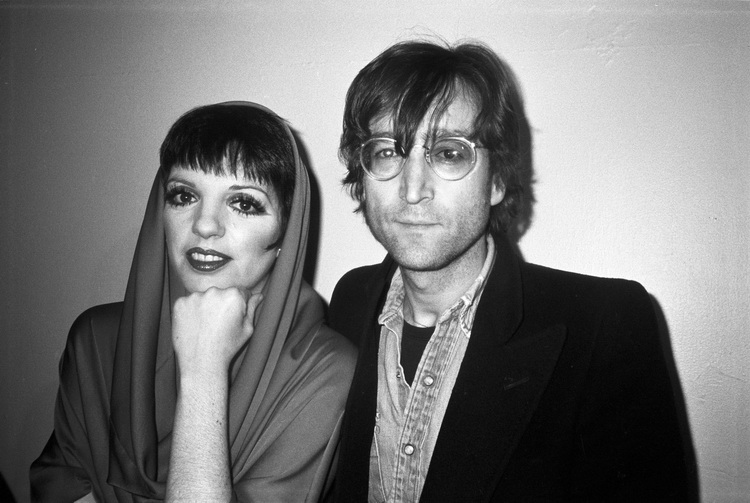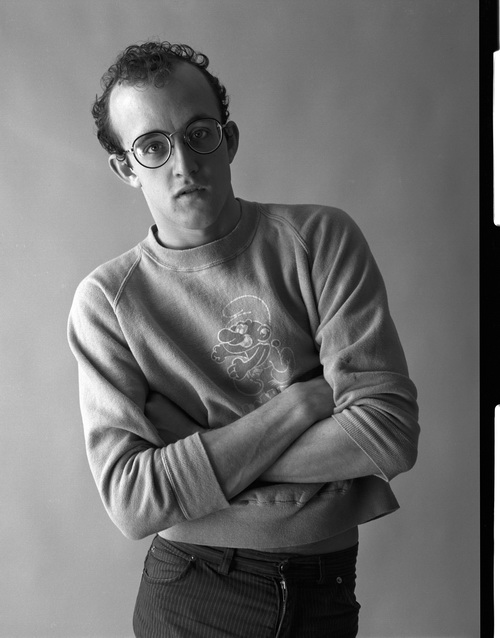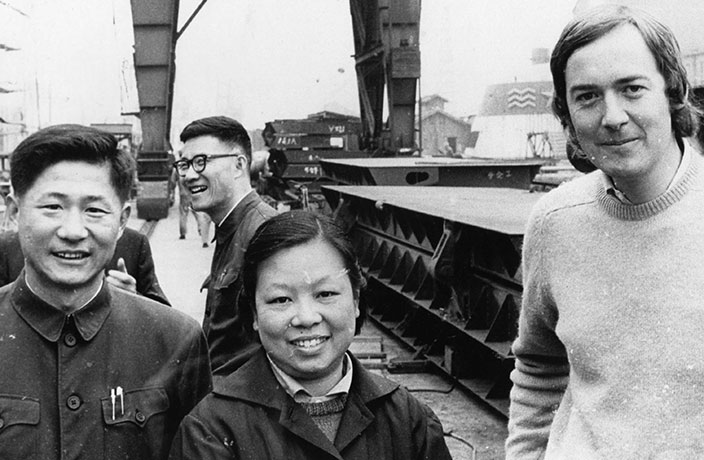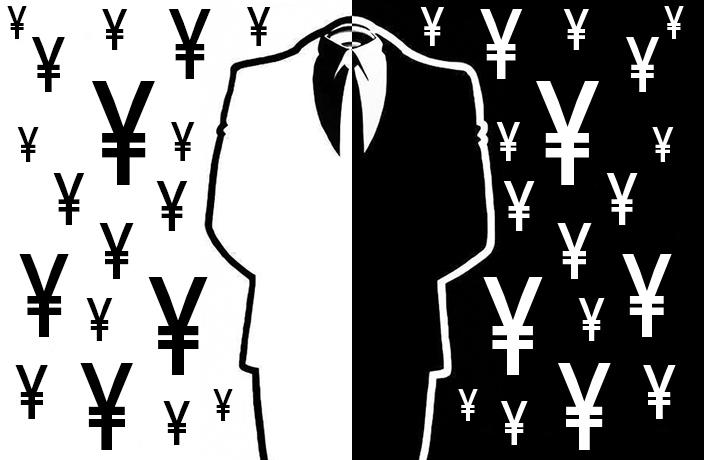Throwback Thursday is when we trawl through the That's archives for a work of dazzling genius written at some point in our past. We then republish it. On a Thursday.
Following on from our Warhol in China cover story last month, we are delighted to announce that the person who captured that 1982 trip is heading to Shanghai for an exhibition. Christopher Makos is the man Warhol described as “the most modern photographer in America,” and the two were close friends and artistic collaborators for many years. Makos will not only be showing his iconic images from the historic Warhol in Beijing series, but a portfolio that chronicles the glitzy and glamorous rock stars, pop stars, poseurs and punks of the New York scene which he has been at the heart for five decades.
.jpg)
Andy Warhol and Liz Taylor at designer Halston's Olympic Tower showroom
Christopher Makos was born in 1948 in Lowell, Massachusetts, the birthplace of pioneering Beat Generation writer Jack Kerouac; a heritage he was oblivious of in his youth. “Growing up in Lowell, I wasn't aware of anything, except how to leave,” he says. “How to grow up fast and figure out how to leave.”
Like Kerouac before him, his creative impulses led him south to New York City - “Somehow I knew it was the life that I wanted” - where he soon landed a job as personal assistant to one of the most important dramatists of the age.
“I was hanging out with artists, writers, poets in the West Village, and become friends with the political writer Dotson Rader, who was a very close friend to Tennessee Williams. At that point in my New York life, I would take any interesting job, and the idea of being the assistant to Tennessee Williams, one of America’s greatest playwrights, was so appealing, so cool.

Calvin Klein at his home on Fire Island
“On my first assignment on a trip to San Francisco, I left his typewriter in the Hertz bus. And it got worse after that. My idea of taking care of his dog, Madame, was to put it in my oversized closet in our hotel room in San Francisco.
“Of course, when Tennessee Williams found his beloved alter ego in a closet, he blew up, and that was the end of my assistantship. But it was fun.”

Andy Warhol and Bill Murray outside Irving Place restaurant, New York City
That debacle wasn’t enough to put Rader off acquainting Makos with the great and the good though, as he also introduced Makos to Warhol. “Dotson Rader took me to Andy Warhol’s opening at the Whitney Museum around 1974 or so, and that’s how, and when, I first met Andy.”

Salvador Dali at Laurent French Restaurant on East 55th Street in New York
Far from being star struck and an instant acolyte, Makos says that, “Frankly, I wasn’t that interested in Andy Warhol, but Dotson and everybody else told me how important it was. He invited me to [his studio] The Factory, and of course I never went.”
Two years later, it was Warhol’s turn to play it cool. “In 1976 I had my first exhibition, called Step On It, where all my photographs were on the floor, and nothing was on the walls,” says Makos.

Andy Warhol kissing John Lennon at the 860 Broadway Factory, part of a kissing series that included Andy Warhol kissing Salvador Dali, Liza Minnelli and Philip Johnson
“I thought this would be a good time to get Andy to my opening. He didn’t come, but [editor of Warhol’s Interview magazine] Bob Colacello did. He invited me to The Factory, and the rest is history…”
Warhol was so impressed with Makos’ 1977 book of celebrity portraits, White Trash, that he bought 1,000 copies and asked Makos to sign them. Explaining that he had learned from Warhol that “art is money and money is art,” Makos charged him US$1 a signature and a kinship was established.

David Bowie in New York, from Makos’ book White Trash
With a picture of Debbie Harry’s thigh on the cover – in long leather boots and short ripped knit Stephen Sprouse dress replete with razor blade – White Trash was a who's who of the New York punk, new wave and arts scene, from the visiting Pistols to the Ramones, Burroughs and a rather haggard-looking David Bowie.
“I have always loved music, and it is always in my life, and at that moment in New York one started hearing about these punk bands playing at CBGB on the Lower East Side - which now is very trendy, very expensive,” says Makos.

Debbie Harry posing for Makos' White Trash in a Stephen Spouse dress in Greenwich Village
“I thought I should go and photograph the scene, and of course what emerged was the confluence of what was happening in my life: hanging out with Tennessee Williams, Andy Warhol and of course the punk music scene, which included Blondie, the Talking Heads, Iggy Pop and even Alice Cooper.”

Mick Jagger at Andy Warhol's summer house in Montauk, N.Y.
The CBGB revolution, Makos says, was in turn a response to the disco lifestyle and that other great NYC party institution of the day, Studio 54.
“The new young set really didn’t want any part of the ‘disco scene.’ After all, they lived in the Lower East Side and wanted to make a world of their own; 54th street, where Studio 54 was, was as far from the Lower East Side as Chicago is from New York. Studio 54 was a place with a velvet rope.
“Studio 54 was if you had enough money,” Makos continues. “If you had some personal style of your own, if you had something special. The doorman ran the show, and at the beginning it was Steve Rubel, who used to love to pick and choose the crowd that would make a night ‘special’ for everyone from Jagger to Lennon to Liza Minnelli to American designer Halston.”

John Lennon and Liza Minnelli: “Andy was doing a portrait of Liza and John just stopped by. He was just hanging around. He was the nicest guy in the world. Easy, fun, nice.”
As for some anecdotes about what went on in the notoriously decadent disco, Makos says there is no point asking him.
“If you ever speak to somebody and they say they can remember, then they weren’t at Studio 54, because most of them were so f*cked up. We were high on everything. Our group of people were so involved; it was really just about the moment. Enjoying the moment.”
Meanwhile, The Factory scene that Makos had been introduced into had calmed somewhat from the 1960s open-door policy and its accompanying drug taking, drag queens, free love and orgies - a world famously documented by Lou Reed on Walk on the Wild Side. Makos ascribes the change in pace to the assassination attempt on Warhol by radical feminist writer and diagnosed paranoid schizophrenic Valerie Solanas back in 1968.
“There were actually four Factories. I was part of the last two, which were at 860 Broadway and then at 33rd Street. After Andy Warhol got shot, the Factory got much more serious and much more of a real business atmosphere.

Gang of Four: Liza Minnelli, Andy Warhol, Bianca Jagger and designer Halston at Studio 54 for the birthday of Bianca Jagger.
“It was about the art of business and the business of art. There was always a daily lunch in the boardroom at 860 Broadway, usually a boxed lunch from Brownies, which was the de facto health food spot of the time.
“[Warhol’s Texan manager] Fred Hughes and Bob Colacello used the lunches for potential portrait clients or potential advertisers for Interview magazine. The lunch would begin, and later in the lunch Andy Warhol would make his appearance, and hopefully the deal would be clinched by that time.”
The business atmosphere didn’t mean the end of a steady stream of socialites, musicians and other glitterati though. “There was always someone interesting, famous or beautiful at The Factory,” says Makos. “Whether it was the latest Calvin Klein model, Mick Jagger or John Lennon, there was always something special going on.”
Moving in these circles also earned Makos an audience with another of the great modernist artists. “Andy Warhol’s art dealer, Luciano Anselmino, who also became my art dealer, took me to Europe and introduced me to Man Ray in Fregenae, Italy,” says Makos.
“I spent time with him, we talked, shared ideas about photography, and the one thing that I learned - he taught me - was always obey your first impressions, pay attention to your instincts.”

OJ Simpson holding a gun to his head: “I was photographing on set of a movie with James Coburn, and OJ was there goofing around and playing with the gun. Little did we all know what this really meant…”
It is his association with Warhol that Makos is most remembered for though.
“If you’re around a very bright star, everybody thinks you are some small planet revolving around that – but sometimes it’s the opposite,” he says.
“I always tried to remind people that friendship is always a two-way street, and try to remind them that Andy was my friend from my perspective, and not that I was his friend. In friendship it’s about each other, not necessarily one person more than the other.
“But I do understand how the general public sees famous people as the primary friend and are usually blinded by the ‘celebrity’ part of any friendship.”
Makos himself doesn’t go in for nostalgia, preferring to pursue new artistic projects. For the last seven years he has been part of an artistic identity with fellow photographer Paul Solberg – who will be traveling to Shanghai with him – under the name The Hilton Brothers, a moniker derived from the Hilton Sisters, 1930s Siamese twin vaudeville stars.
“I understand people’s fascination with the New York of the 70s and 80s, because that was the era that created me as an artist,” reflects Makos. “But one of the things that Man Ray and Warhol both taught me – was a central Warhol theme – was to live in the moment. Reminiscing too mush makes you melancholy. You get old living in the past.”
Keith Haring and Jean-Michel Basquiat


Both starting out as graffiti artists in New York City in the late 1970s, Keith Haring and Jean-Michel Basquiat evolved into two of the bright young things dominating the bull market of 1980s New York art. Basquiat was an acclaimed Neo-expressionist and Primitivist painter, while Haring's simple and striking imagery expressing concepts of birth, death and war became a widely recognized visual language.
“I met Keith when he had just moved from Pennsylvania and was just going around the city, going to openings, giving out his famous ‘baby’ buttons,” says Makos. “I took Keith to The Factory and introduced Keith to Andy, and then Keith introduced me to Jean-Michel Basquiat, and the same thing happened. Andy loved meeting new talent.”
Lady Warhol
.jpg)
Lady Warhol
This photograph of Andy Warhol comes from Makos’ Lady Warhol series, where they used seven different wigs and full makeup to transform the older artist into a series of striking female alter egos over 349 frames fired off at The Factory over two days in 1981.
“We played with this idea of how people would perceive Warhol,” Makos says. “When you put makeup on a man and change the way he looks and put a wig on, it completely changes the way you look at a particular person.”
Some have speculated that with these sessions Warhol was trying to get closer to heroines like Marilyn Monroe, Liz Taylor and Joan Collins, who he depicted in his famous silk screens, but Makos thinks he was stepping into the characters of the rich female collectors who paid US$25,000 a time to commission a portrait from Warhol.
Makos has described working with Warhol as being like “being on a non-stop date. When artists get together they like to play and be creative. Warhol was one of the biggest playmates and I was lucky enough to play in his sandbox for a while.”
All Photos by Christopher Makos. This article first appeared in the June 2013 issue of That's Shanghai. To see more Throwback Thursday posts, click here.






















0 User Comments